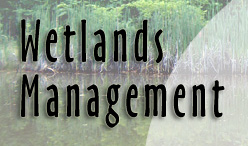|
Wild rice is an aquatic plant that can produce abundant food
for waterfowl, muskrats, and other herbivores Wild rice beds
serve as cover for young ducks and can also attract
rails and other birds. Planting wild rice can stabilize
loose soil and prevent soil nutrient loss. Once common in the Midwest, wild rice has
been lost in much of its range. Plans are in place in many
states to restore this important beneficial plant.
|
Will wild
rice grow on your site?
|
Wild rice
grows best in flowing water, this includes wetlands with
inlets and outlets. Motionless small lakes and ponds are not
ideal. Areas with seasonal flows may support rice growth,
but production may be unreliable. Some water fluctuation is
desirable as it discourages growth of perennial plants,
however, fluctuations should not be extreme. Water depths of
½ - 3 feet are optimal
for wild rice.
Exceedingly
dark, stained water may not be suitable for growing wild
rice as it hinders penetration of sunlight. Deep organic
soils are ideal for wild rice growth. It may be difficult to
establish wild rice in areas with existing perennial
vegetation.
|
Options for obtaining and planting wild rice seed:
|
Wild rice seed
can be purchased from nurseries specializing in wildlife
foods. When possible, try to find a supply of seed that is
as near to your planting site as possible. Harvesting by
hand provides the freshest, local seed source. A permit is
required if you opt to harvest seeds yourself.
Seeds should
be kept cool and moist prior to planting. Wild rice should
be planted before the fall freeze or in the spring after
danger of frost. For broadcast spreading water 1 to 3 feet
deep, use 50 pounds per acre. If seeding into a prepared
seedbed, use 25 pounds per acre. Plantings should be
repeated every year for 3 years.
For more
information on wild rice establishment:
Natural Resource Conservation Service: Wild Rice
Establishment
Wisconsin DNR's
Wetland Restoration Handbook for Wisconsin Landowners,
Ch.12: Wild Rice Community Restoration
|

